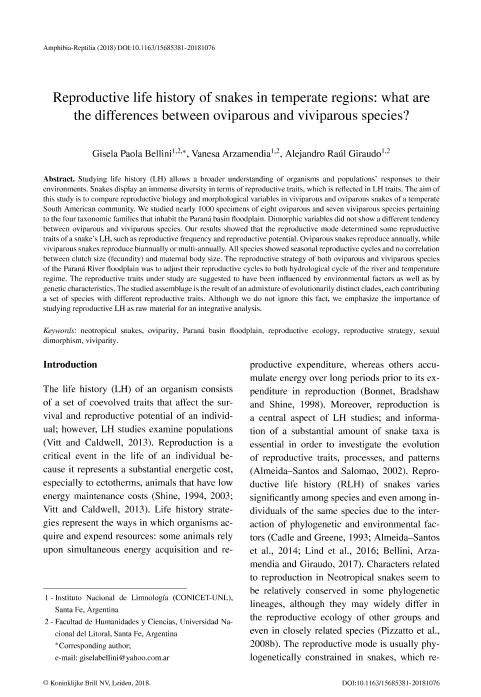Artículo
Reproductive life history of snakes in temperate regions: What are the differences between oviparous and viviparous species?
Fecha de publicación:
11/2018
Editorial:
Brill Academic Publishers
Revista:
Amphibia-Reptilia
ISSN:
0173-5373
Idioma:
Inglés
Tipo de recurso:
Artículo publicado
Clasificación temática:
Resumen
Studying life history (LH) allows a broader understanding of organisms and populations? responses to theirenvironments. Snakes display an immense diversity in terms of reproductive traits, which is reflected in LH traits. The aim ofthis study is to compare reproductive biology and morphological variables in viviparous and oviparous snakes of a temperateSouth American community. We studied nearly 1000 specimens of eight oviparous and seven viviparous species pertainingto the four taxonomic families that inhabit the Paraná basin floodplain. Dimorphic variables did not show a different tendencybetween oviparous and viviparous species. Our results showed that the reproductive mode determined some reproductivetraits of a snake?s LH, such as reproductive frequency and reproductive potential. Oviparous snakes reproduce annually, whileviviparous snakes reproduce biannually or multi-annually. All species showed seasonal reproductive cycles and no correlationbetween clutch size (fecundity) and maternal body size. The reproductive strategy of both oviparous and viviparous speciesof the Paraná River floodplain was to adjust their reproductive cycles to both hydrological cycle of the river and temperatureregime. The reproductive traits under study are suggested to have been influenced by environmental factors as well as bygenetic characteristics. The studied assemblage is the result of an admixture of evolutionarily distinct clades, each contributinga set of species with different reproductive traits. Although we do not ignore this fact, we emphasize the importance ofstudying reproductive LH as raw material for an integrative analysis.
Palabras clave:
NEOTROPICAL SNAKES
,
OVIPARITY
,
PARANA BASIN FLOODPLAIN
,
REPRODUCTIVE ECOLOGY
Archivos asociados
Licencia
Identificadores
Colecciones
Articulos(INALI)
Articulos de INST.NAC.DE LIMNOLOGIA (I)
Articulos de INST.NAC.DE LIMNOLOGIA (I)
Citación
Bellini, Gisela Paola; Arzamendia, Vanesa; Giraudo, Alejandro Raul; Reproductive life history of snakes in temperate regions: What are the differences between oviparous and viviparous species?; Brill Academic Publishers; Amphibia-Reptilia; 40; 3; 11-2018; 291-303
Compartir
Altmétricas




